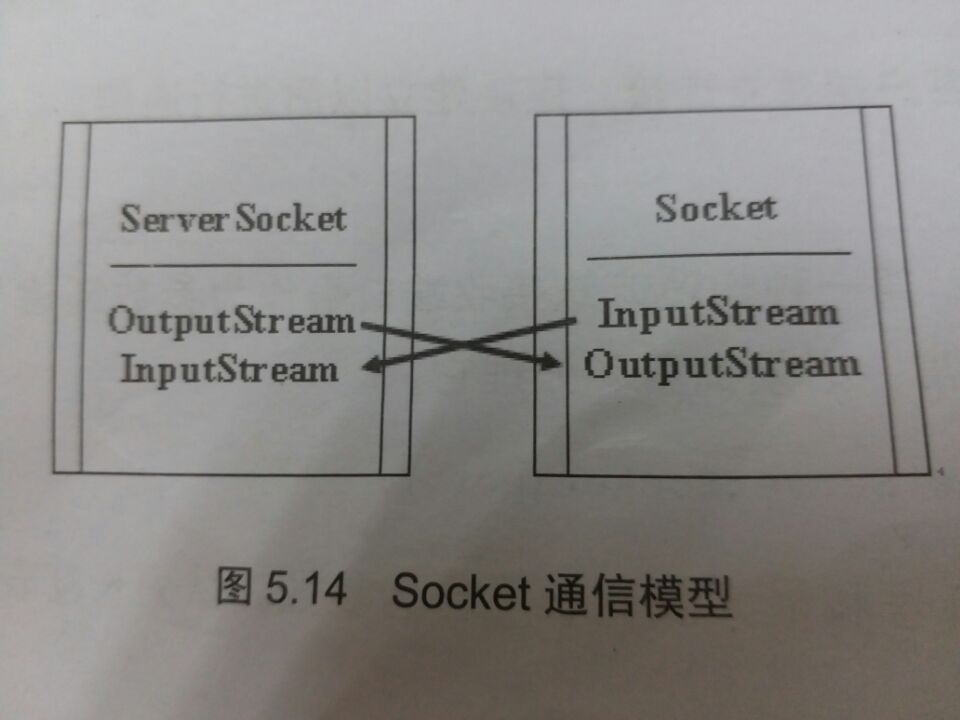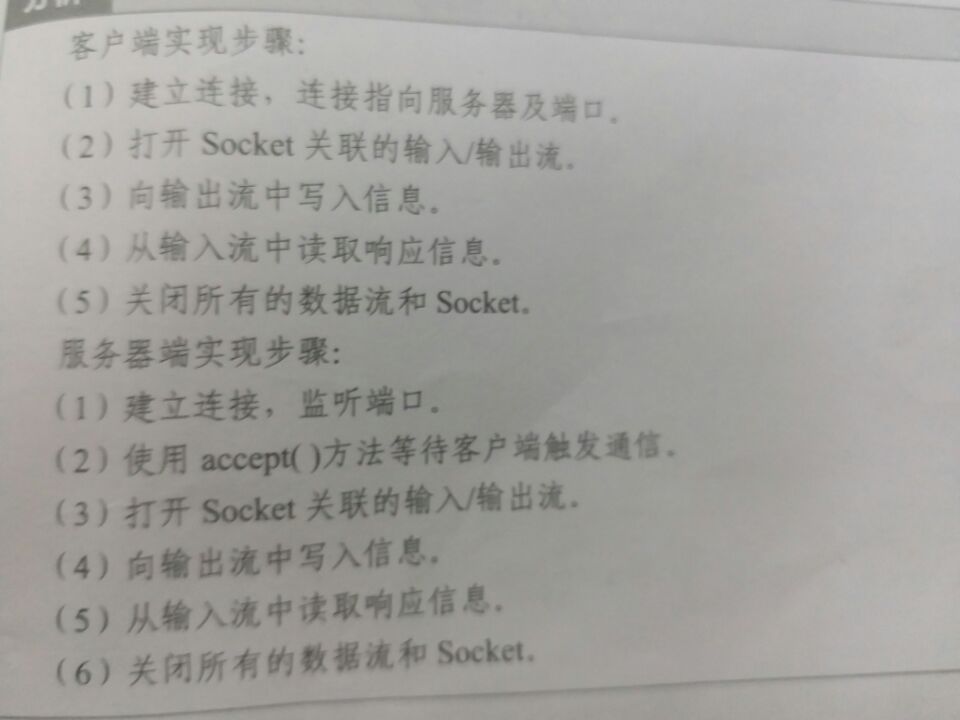------------------------------------网络编程(Socket)(TCP )
Posted 【宁静的夏天】
tags:
篇首语:本文由小常识网(cha138.com)小编为大家整理,主要介绍了------------------------------------网络编程(Socket)(TCP )相关的知识,希望对你有一定的参考价值。
1.Java.net 包提供若干支持基于套接字的客户端/服务器通信的类。
2.java.net包中常有的类有Socket、ServerSocket、DatagramPacket、InetAddress、URL、URLConnection和URLEncoder等
3.为了监听客户端的连接请求,可以使用ServerSocket类。Socket类实现用于网络上进程间通信的套接字.DatagramSocket类使用UDP协议实现客户端和服务器套接字。DatagramPacket类使用DatagramSocket类的对象封装设置和收到的收据情报。InetAddress类表示Internet地址。在创建数据报报文和Socket对象时,可以使用InetAddress类。
 ,Socket通信模式图
,Socket通信模式图
3.2个断点在TCP协议的Socket编程中,经常一个作为客户端,一个作为服务器端。也就是client-server模型,如上图;
4.Socket类
1)Socket对象在客户端和服务器之间建立连接。构造方法创建套接字,并将套接字连接至给定的主机和端口。以下是与此Socket对象关联的构造方法和一些常用方法。
(1)构造方法
第一种构造方法以主机名和端口号作为参数来创建一个Socket对象。创建Socket对象时可能抛出异常UnknowHostException或IOException异常,必须捕捉它们。
Socket s=new Socket(Hhost,port);
两一种构造方法以InetAddress对象和端口作为参数来创建一个Socket对象。创建Socket对象时可能抛出异常UnknowHostException或IOException异常,必须捕捉它们。
Socket s=new Socket(address,port);
(2)常用方法
InetAddress getInetAddress();//返回与Socket对象关联的InetAddress
int getPort();//返回此Socket 对象所连接的远程端口
int getLocalPort();//返回此Socket对象所连接的本地端口
InputStream getInputStream();//返回与此套接关联的InputStream
OutputStream getOutputStream();//返回于此套接关联的OutputStream
void close();//关闭该Socket
5.ServerSocket类
ServerSocket对象等待客户建立连接,连接建立以后进行通信。
1)构造方法
第一种构造方法接收端口号作为参数创建ServerSocket对象。创建此对象时,可能抛出IOExption异常,必须捕捉和处理。
ServerSocket ss=new ServerSocket(port);
另一种构造方法 接收端口号和最大队列长度作为参数。队列长度表示系统在拒绝连接前可以拥有的最大客户端数。
ServerSocket ss=new ServerSocket(port,maxqu);
Socket类中列出的方法也适用于ServerSocket类。此外,ServerSocket类具有的方法有accept(),此方法用于等待客户端触发通信,这样Socket对象就可用于进一步的数据传送。
6.实现单用户登录
Socket 网络编程一般可以划分如下4个步骤进行:
(1)建立连接
(2)打开Socket关联的输入/输出流
(3)从数据流中写入信息和读取信息
(4)关闭所有的数据流和Socket
.
/** * 客户端 * @param args * @throws IOException * @throws UnknownHostException */ public static void main(String[] args) throws UnknownHostException, IOException { //建立客户端Socket连接,指定服务器的位置为本机立即端口8800 Socket socket=new Socket("localhost",8800); OutputStream os=socket.getOutputStream(); InputStream is = socket.getInputStream(); String str="用户名:tom,用户密码:123456"; os.write(str.getBytes()); socket.shutdownOutput(); //接收服务器端的响应,即从输入流读取信息 String reply=null; BufferedReader br=new BufferedReader(new InputStreamReader(is)); while ((reply=br.readLine())!=null){ System.out.println("我是客户端,服务器的响应为:"+reply); } br.close(); is.close(); os.close(); }
/** * @param args * 服务端 * @throws IOException */ public static void main(String[] args) throws IOException { //建立一个服务器Socket(ServerSocket),指定端口8800bin开始监听 ServerSocket serverSocket=new ServerSocket(8800); //使用accept()方法得到Socket对象 Socket socket = serverSocket.accept(); InputStream is = socket.getInputStream(); OutputStream os = socket.getOutputStream(); BufferedReader br=new BufferedReader(new InputStreamReader(is)); String info=null; while ((info=br.readLine())!=null) { System.out.println("我是服务器,客户的信息是:"+info); } String reply="欢迎你,登录成功!"; os.write(reply.getBytes()); os.close(); br.close(); is.close();
2)把对象传递,建一个Student类里面有三个属性和set/get方法
/** * 客户端 * @param args * @throws IOException * @throws UnknownHostException */ public static void main(String[] args) throws UnknownHostException, IOException { Socket socket=new Socket("localhost",8800); OutputStream os = socket.getOutputStream(); InputStream is = socket.getInputStream(); //序列化对象 ObjectOutputStream oos=new ObjectOutputStream(os); Student student=new Student(); student.setID(0); student.setName("小明"); student.setSEX("男"); oos.writeObject(student); socket.shutdownOutput(); //接收服务器端的响应,即从输入流读取信息 BufferedReader br=new BufferedReader(new InputStreamReader(is)); String info=null; while ((info=br.readLine())!=null) { System.out.println("我是客户端,服务器的信息是:"+info); } br.close(); oos.close(); is.close(); os.close(); }
/** * @param args * 服务端 * @throws IOException * @throws ClassNotFoundException */ public static void main(String[] args) throws IOException, ClassNotFoundException { //建立一个服务器Socket(ServerSocket),指定端口8800bin开始监听 ServerSocket serverSocket=new ServerSocket(8800); //使用accept()方法得到Socket对象 Socket socket = serverSocket.accept(); InputStream is = socket.getInputStream(); OutputStream os = socket.getOutputStream(); ObjectInputStream ois=new ObjectInputStream(is); Student student =(Student) ois.readObject(); if (student!=null) { System.out.println("我是服务器端,客户端的信息是"+student.getID()+student .getName()+student.getSEX()); } String str="欢迎使用!"; os.write(str.getBytes()); os.close(); ois.close(); is.close(); } }
3)实现多个客户端用户登录
/** * 客户端 * @param args * @throws IOException * @throws UnknownHostException */ public static void main(String[] args) throws UnknownHostException, IOException { Socket socket=new Socket("localhost",8800); OutputStream os = socket.getOutputStream(); InputStream is = socket.getInputStream(); //序列化对象g ObjectOutputStream oos=new ObjectOutputStream(os); Student student2=new Student(); student2.setID(2); student2.setName("小明"); student2.setSEX("男"); oos.writeObject(student2); socket.shutdownOutput(); //接收服务器端的响应,即从输入流读取信息 BufferedReader br=new BufferedReader(new InputStreamReader(is)); String info=null; while ((info=br.readLine())!=null) { System.out.println("我是客户端,服务器的信息是:"+info); } br.close(); oos.close(); is.close(); os.close(); }
//建立多个服务器Socket(ServerSocket),指定端口8800bin开始监听 ServerSocket serverSocket=new ServerSocket(8800);
public class LoginThread extends Thread{ Socket socket=null; //每启动一个线程,连接响应的Socket public LoginThread(Socket socket){ this.socket=socket; } //启动线程,即响应客户请求 public void run(){ try { InputStream is = socket.getInputStream(); OutputStream os = socket.getOutputStream(); ObjectInputStream ois=new ObjectInputStream(is); Student student; try { student = (Student) ois.readObject(); if (student!=null) { System.out.println("我是服务器端,客户端的信息是"+student.getID()+student .getName()+student.getSEX()); } String str="欢迎使用!"; os.write(str.getBytes()); os.close(); ois.close(); is.close(); } catch (ClassNotFoundException e) { e.printStackTrace(); } } catch (IOException e) { e.printStackTrace(); } } }
/** * 客户端 * @param args * @throws IOException * @throws UnknownHostException */ public static void main(String[] args) throws UnknownHostException, IOException { Socket socket=new Socket("localhost",8800); OutputStream os = socket.getOutputStream(); InputStream is = socket.getInputStream(); //序列化对象 ObjectOutputStream oos=new ObjectOutputStream(os); Student student=new Student(); student.setID(0); student.setName("小明"); student.setSEX("男"); oos.writeObject(student); socket.shutdownOutput(); //接收服务器端的响应,即从输入流读取信息 BufferedReader br=new BufferedReader(new InputStreamReader(is)); String info=null; while ((info=br.readLine())!=null) { System.out.println("我是客户端,服务器的信息是:"+info); } br.close(); oos.close(); is.close(); os.close(); }
Socket socket=null; while (true) { socket=serverSocket.accept(); LoginThread loginThread=new LoginThread(socket); loginThread.start(); }
以上是关于------------------------------------网络编程(Socket)(TCP )的主要内容,如果未能解决你的问题,请参考以下文章